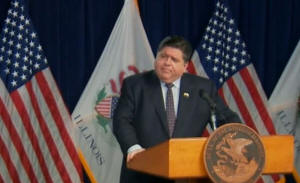Regions could have some mitigations loosened starting Jan. 15
 Send a link to a friend
Send a link to a friend
[January 07, 2021]
By GRACE BARBIC
Capitol News Illinois
gbarbic@capitolnewsillinois.com
 SPRINGFIELD – Statewide Tier 3 COVID-19
mitigations could be lifted within 10 days. SPRINGFIELD – Statewide Tier 3 COVID-19
mitigations could be lifted within 10 days.
Starting Jan.15, exactly one incubation period from New Year’s Day, any
region that has met requirements for a reduction of mitigations will be
able to move out of the Tier 3 mitigation plan, Gov. J.B. Pritzker
announced Wednesday.
“I’m cautiously optimistic as there are some early signs indicating that
some regions have made real progress and won’t reverse that progress
this week or next,” Pritzker said.
The entire state has been under Tier 3 restrictions since Nov. 20 in an
effort to combat a potential holiday surge in cases. Under these
increased restrictions businesses are required to follow 25 percent
capacity limits and close bars and restaurants to indoor service – a
mitigation that will still be in place even when a region moves back to
Tier 2.
Pritzker said that despite not seeing a post-Thanksgiving surge, he is
still advising Tier 3 restrictions be upheld for one incubation period,
or 14 days, to ensure infection rates remain as low as possible.

After Jan.15, regions will be able proceed past Tier 2, which would
allow restaurants and bars to reopen for indoor service, depending on
their future infection and hospitalization rates.
Because of high demand for the COVID-19 vaccine, the U.S. Centers for
Disease Control and Prevention’s Advisory Committee on Immunization
Practices recommended two initial priority groups receive the first
rounds of vaccination.
Those in Phase 1A, who are currently receiving vaccines, include health
care workers and residents of long-term care facilities.
Phase 1B will include Illinois residents age 65 years or older and
non-healthcare frontline essential workers. ACIP recommended residents
75 years or older be prioritized, but Illinois reduced the age by 10
years. Pritzker noted the average age of COVID-19 deaths is 81 for white
residents, 72 for Black residents and 68 for Latino residents.
Illinois Department of Public Health Director Ngozi Ezike supported
lowering the vaccine eligibility age, noting that Latino and Black
residents have statistically been dying from COVID-19 at three times the
rate of white residents.
“Generally, Latinx and Black populations have been disproportionately
impacted by COVID-19 with data showing related deaths at younger ages,”
Ezike said. “We are hopeful that by lowering the eligibility age to 65
years we can help reduce this disparity.”
About 3.2 million people throughout the state would be eligible for
vaccination in Phase 1B. These essential workers include first
responders, education workers, manufacturing, distribution and
agriculture workers, grocery store workers, U.S. Postal service workers,
public transit employees, corrections workers and incarcerated people,
among others.
The Illinois National Guard will be assisting in the development of mass
vaccination sites. The state will also be increasing the number of
providers to support widespread testing when the time comes.
[to top of second column]
|

Gov. JB Pritzker speaks at a COVID-19 briefing in
Chicago Wednesday, announcing Tier 3 mitigations could be lifted in
some regions on Jan. 15. (Credit: Blueroomstream.com)

Phase 1B will begin once Phase 1A is substantially complete, but a
specific time period is not yet clear. Although about one-third of
the healthcare workforce has already been vaccinated, Pritzker said
that many healthcare workers and long-term care facility residents
are still in the process of receiving the vaccine. Ongoing vaccine
administration and a decrease in federal vaccine distribution could
delay the move to the next phase.
The increase in federal vaccine distribution relies heavily on
whether the Biden administration will implement the Defense
Production Act. President Donald Trump invoked this Cold War-era law
in response to the pandemic, giving him emergency authority to
control domestic industries.
The Defense Production Act was most recently used to prevent the
hoarding of supplies, limit the export of medical goods like
personal protective equipment and increase the production of
critical supplies. Pritzker anticipates that there will be a
significant increase in vaccine distribution once the DPA is invoked
under Biden.
He also noted that Johnson and Johnson and AstraZeneca, along with a
few other companies, are in the process of applying for Emergency
Use Authorization for their own coronavirus vaccines through the
U.S. Food and Drug Administration.
“Whenever that is granted, that will give us other manufacturing
facilities to rely upon,” Pritzker said. “So I’m hopeful that all of
those things will allow vaccine production to increase
significantly.”
The state reported another 139 COVID-19-related deaths Wednesday as
the confirmed death count in Illinois from the virus rose to 17,096.
Hospitalizations and positivity rates for COVID remained roughly
level from the previous day, with the seven-day rolling average case
positivity rate falling to 8.4 percent, decreasing for the second
straight day.
As of Tuesday night, 3,928 individuals were hospitalized with
COVID-19 in Illinois, an increase of 23 from the day prior. There
were 812 individuals in intensive care unit beds, an increase of 12
from the day before, and 451 individuals on ventilators, a decrease
of six from Monday night.

The hospitalization numbers appeared to be leveling, with 27 percent
of beds available statewide, 22 percent of ICU beds available and 73
percent of ventilators.
This story has been updated with more information from the
governor's briefing.
Capitol News Illinois is a nonprofit, nonpartisan news service
covering state government and distributed to more than 400
newspapers statewide. It is funded primarily by the Illinois Press
Foundation and the Robert R. McCormick Foundation.
[© 2021 Thomson Reuters. All rights
reserved.] Copyright 2021 Reuters. All rights reserved. This material may not be published,
broadcast, rewritten or redistributed.
Thompson Reuters is solely responsible for this content. |